Health and Social Care: Promoting Positive Behaviour Strategies Report
VerifiedAdded on 2020/06/04
|6
|1527
|58
Report
AI Summary
This report examines strategies for promoting positive behaviour within Health and Social Care (HSC) settings. It explores the application of legislation regarding restrictive interventions and discusses various interventions, including Functional Behaviour Analysis (FBA), to foster positive behaviours. The report emphasizes the importance of implementing the least restrictive interventions first and outlines necessary safeguards when physical interventions are required. It differentiates between proactive and reactive strategies, highlighting the significance of a person-centred approach in addressing challenging behaviours. Best practices for promoting positive behaviour are analyzed, alongside steps to maintain the dignity and respect of individuals and check their well-being following incidents. The report references various books and journals to support its findings, providing a comprehensive overview of positive behaviour management in HSC.
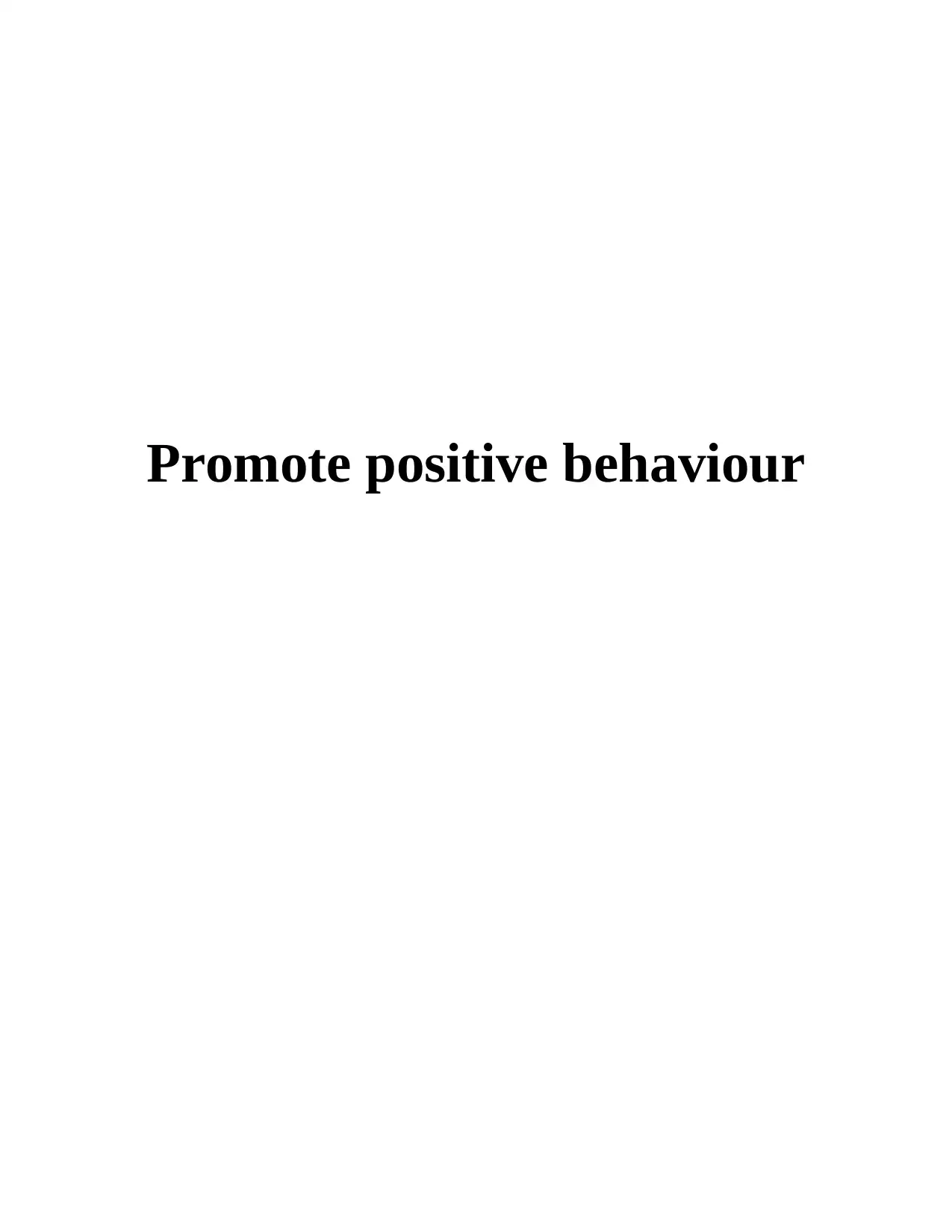
Promote positive behaviour
Paraphrase This Document
Need a fresh take? Get an instant paraphrase of this document with our AI Paraphraser
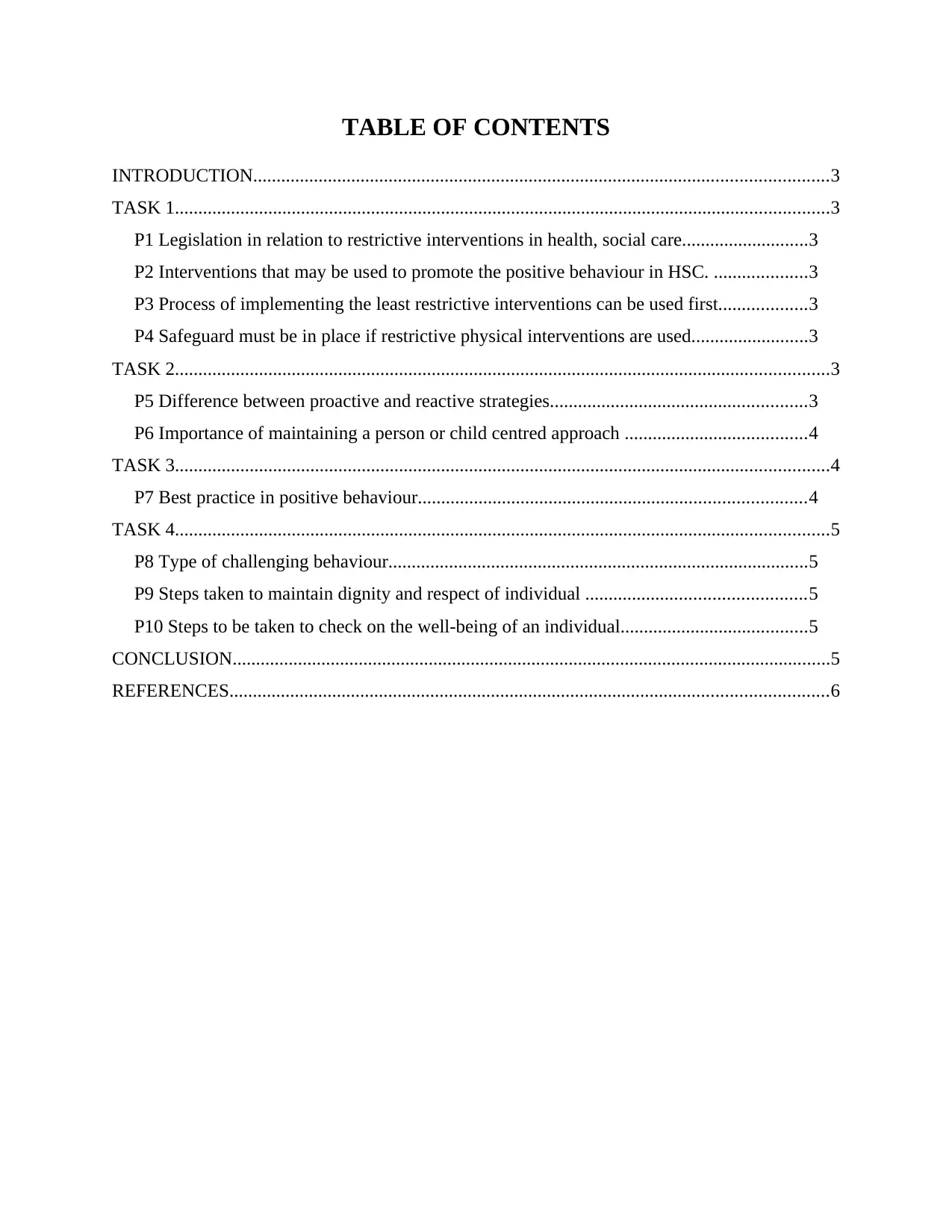
TABLE OF CONTENTS
INTRODUCTION...........................................................................................................................3
TASK 1............................................................................................................................................3
P1 Legislation in relation to restrictive interventions in health, social care...........................3
P2 Interventions that may be used to promote the positive behaviour in HSC. ....................3
P3 Process of implementing the least restrictive interventions can be used first...................3
P4 Safeguard must be in place if restrictive physical interventions are used.........................3
TASK 2............................................................................................................................................3
P5 Difference between proactive and reactive strategies.......................................................3
P6 Importance of maintaining a person or child centred approach .......................................4
TASK 3............................................................................................................................................4
P7 Best practice in positive behaviour...................................................................................4
TASK 4............................................................................................................................................5
P8 Type of challenging behaviour..........................................................................................5
P9 Steps taken to maintain dignity and respect of individual ...............................................5
P10 Steps to be taken to check on the well-being of an individual........................................5
CONCLUSION................................................................................................................................5
REFERENCES................................................................................................................................6
INTRODUCTION...........................................................................................................................3
TASK 1............................................................................................................................................3
P1 Legislation in relation to restrictive interventions in health, social care...........................3
P2 Interventions that may be used to promote the positive behaviour in HSC. ....................3
P3 Process of implementing the least restrictive interventions can be used first...................3
P4 Safeguard must be in place if restrictive physical interventions are used.........................3
TASK 2............................................................................................................................................3
P5 Difference between proactive and reactive strategies.......................................................3
P6 Importance of maintaining a person or child centred approach .......................................4
TASK 3............................................................................................................................................4
P7 Best practice in positive behaviour...................................................................................4
TASK 4............................................................................................................................................5
P8 Type of challenging behaviour..........................................................................................5
P9 Steps taken to maintain dignity and respect of individual ...............................................5
P10 Steps to be taken to check on the well-being of an individual........................................5
CONCLUSION................................................................................................................................5
REFERENCES................................................................................................................................6
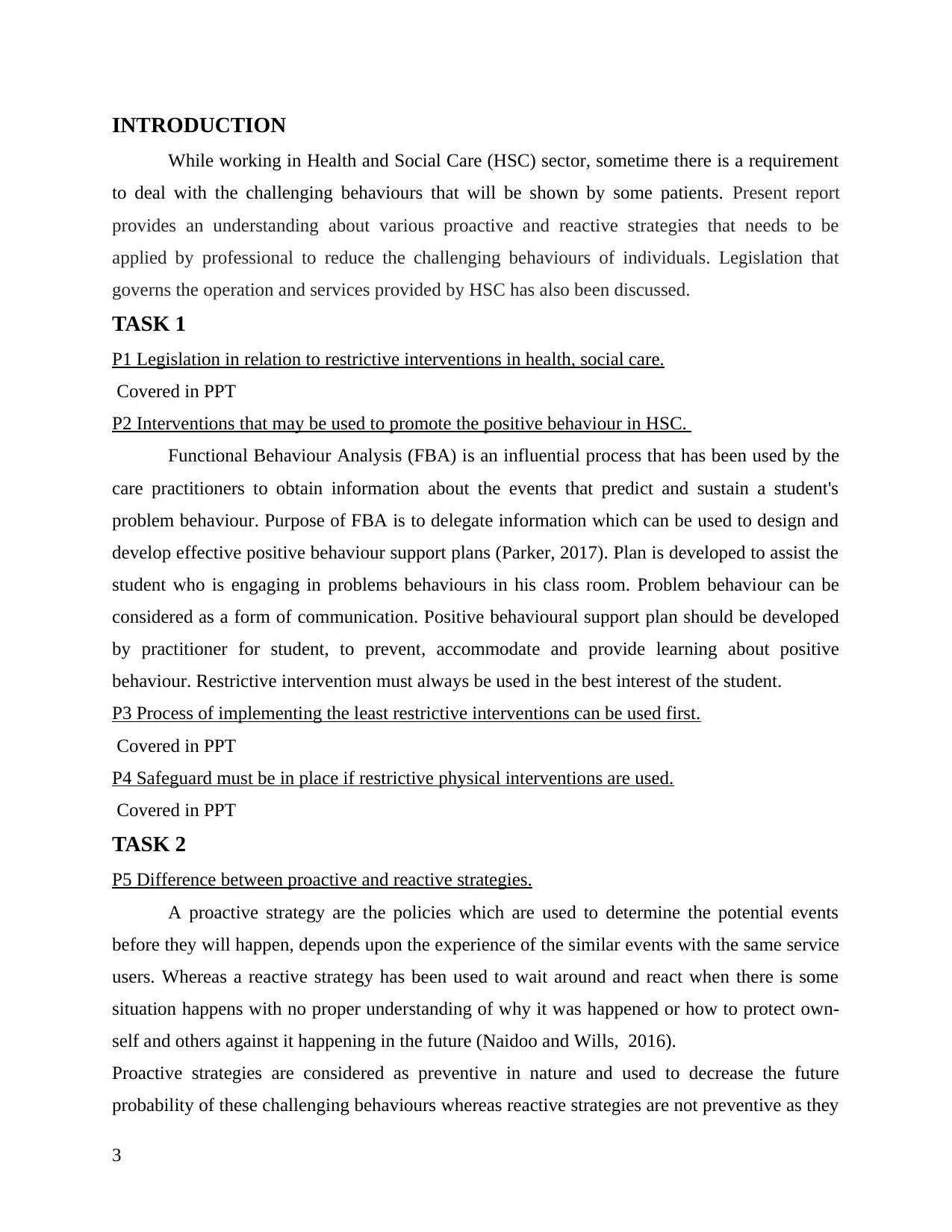
INTRODUCTION
While working in Health and Social Care (HSC) sector, sometime there is a requirement
to deal with the challenging behaviours that will be shown by some patients. Present report
provides an understanding about various proactive and reactive strategies that needs to be
applied by professional to reduce the challenging behaviours of individuals. Legislation that
governs the operation and services provided by HSC has also been discussed.
TASK 1
P1 Legislation in relation to restrictive interventions in health, social care.
Covered in PPT
P2 Interventions that may be used to promote the positive behaviour in HSC.
Functional Behaviour Analysis (FBA) is an influential process that has been used by the
care practitioners to obtain information about the events that predict and sustain a student's
problem behaviour. Purpose of FBA is to delegate information which can be used to design and
develop effective positive behaviour support plans (Parker, 2017). Plan is developed to assist the
student who is engaging in problems behaviours in his class room. Problem behaviour can be
considered as a form of communication. Positive behavioural support plan should be developed
by practitioner for student, to prevent, accommodate and provide learning about positive
behaviour. Restrictive intervention must always be used in the best interest of the student.
P3 Process of implementing the least restrictive interventions can be used first.
Covered in PPT
P4 Safeguard must be in place if restrictive physical interventions are used.
Covered in PPT
TASK 2
P5 Difference between proactive and reactive strategies.
A proactive strategy are the policies which are used to determine the potential events
before they will happen, depends upon the experience of the similar events with the same service
users. Whereas a reactive strategy has been used to wait around and react when there is some
situation happens with no proper understanding of why it was happened or how to protect own-
self and others against it happening in the future (Naidoo and Wills, 2016).
Proactive strategies are considered as preventive in nature and used to decrease the future
probability of these challenging behaviours whereas reactive strategies are not preventive as they
3
While working in Health and Social Care (HSC) sector, sometime there is a requirement
to deal with the challenging behaviours that will be shown by some patients. Present report
provides an understanding about various proactive and reactive strategies that needs to be
applied by professional to reduce the challenging behaviours of individuals. Legislation that
governs the operation and services provided by HSC has also been discussed.
TASK 1
P1 Legislation in relation to restrictive interventions in health, social care.
Covered in PPT
P2 Interventions that may be used to promote the positive behaviour in HSC.
Functional Behaviour Analysis (FBA) is an influential process that has been used by the
care practitioners to obtain information about the events that predict and sustain a student's
problem behaviour. Purpose of FBA is to delegate information which can be used to design and
develop effective positive behaviour support plans (Parker, 2017). Plan is developed to assist the
student who is engaging in problems behaviours in his class room. Problem behaviour can be
considered as a form of communication. Positive behavioural support plan should be developed
by practitioner for student, to prevent, accommodate and provide learning about positive
behaviour. Restrictive intervention must always be used in the best interest of the student.
P3 Process of implementing the least restrictive interventions can be used first.
Covered in PPT
P4 Safeguard must be in place if restrictive physical interventions are used.
Covered in PPT
TASK 2
P5 Difference between proactive and reactive strategies.
A proactive strategy are the policies which are used to determine the potential events
before they will happen, depends upon the experience of the similar events with the same service
users. Whereas a reactive strategy has been used to wait around and react when there is some
situation happens with no proper understanding of why it was happened or how to protect own-
self and others against it happening in the future (Naidoo and Wills, 2016).
Proactive strategies are considered as preventive in nature and used to decrease the future
probability of these challenging behaviours whereas reactive strategies are not preventive as they
3
⊘ This is a preview!⊘
Do you want full access?
Subscribe today to unlock all pages.

Trusted by 1+ million students worldwide
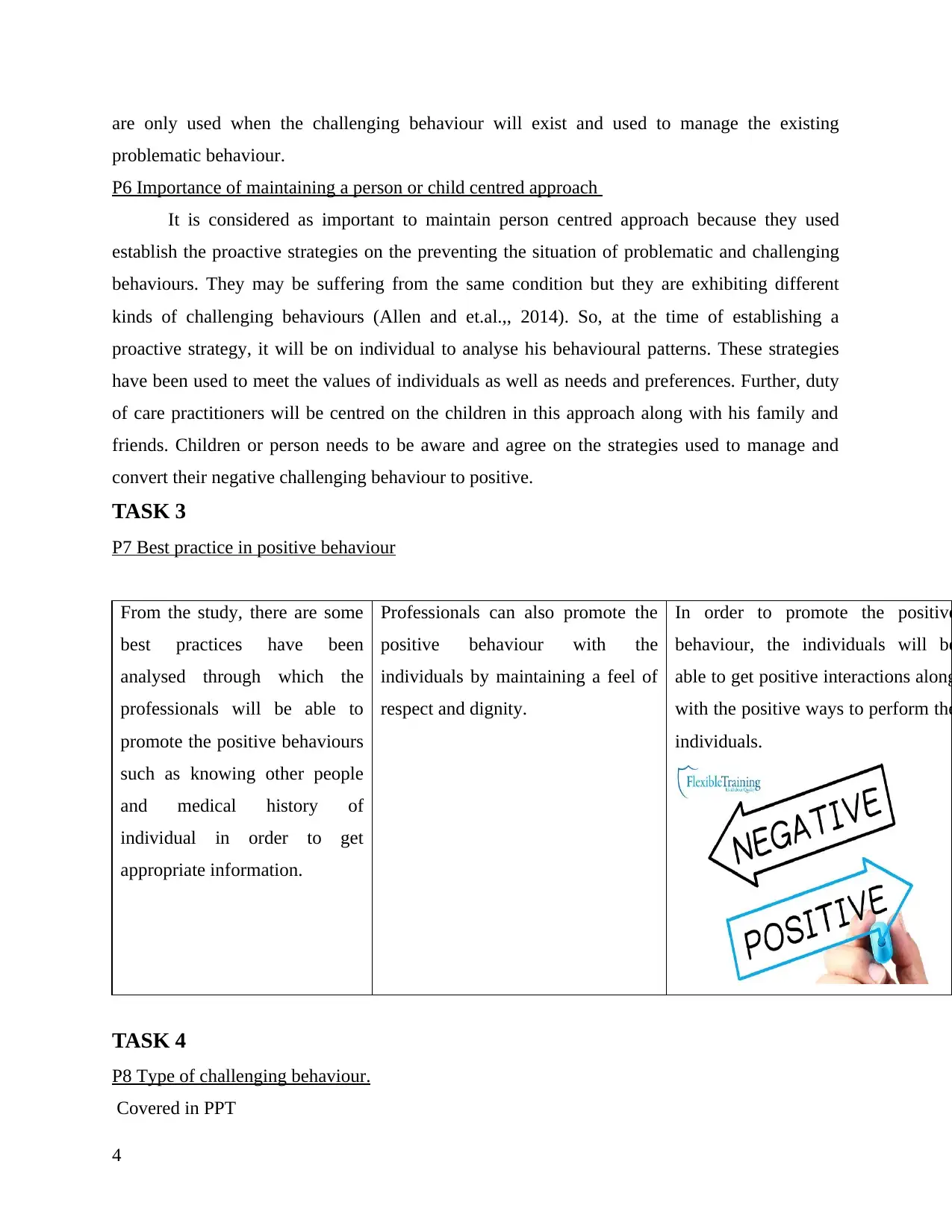
are only used when the challenging behaviour will exist and used to manage the existing
problematic behaviour.
P6 Importance of maintaining a person or child centred approach
It is considered as important to maintain person centred approach because they used
establish the proactive strategies on the preventing the situation of problematic and challenging
behaviours. They may be suffering from the same condition but they are exhibiting different
kinds of challenging behaviours (Allen and et.al.,, 2014). So, at the time of establishing a
proactive strategy, it will be on individual to analyse his behavioural patterns. These strategies
have been used to meet the values of individuals as well as needs and preferences. Further, duty
of care practitioners will be centred on the children in this approach along with his family and
friends. Children or person needs to be aware and agree on the strategies used to manage and
convert their negative challenging behaviour to positive.
TASK 3
P7 Best practice in positive behaviour
From the study, there are some
best practices have been
analysed through which the
professionals will be able to
promote the positive behaviours
such as knowing other people
and medical history of
individual in order to get
appropriate information.
Professionals can also promote the
positive behaviour with the
individuals by maintaining a feel of
respect and dignity.
In order to promote the positive
behaviour, the individuals will be
able to get positive interactions along
with the positive ways to perform the
individuals.
TASK 4
P8 Type of challenging behaviour.
Covered in PPT
4
problematic behaviour.
P6 Importance of maintaining a person or child centred approach
It is considered as important to maintain person centred approach because they used
establish the proactive strategies on the preventing the situation of problematic and challenging
behaviours. They may be suffering from the same condition but they are exhibiting different
kinds of challenging behaviours (Allen and et.al.,, 2014). So, at the time of establishing a
proactive strategy, it will be on individual to analyse his behavioural patterns. These strategies
have been used to meet the values of individuals as well as needs and preferences. Further, duty
of care practitioners will be centred on the children in this approach along with his family and
friends. Children or person needs to be aware and agree on the strategies used to manage and
convert their negative challenging behaviour to positive.
TASK 3
P7 Best practice in positive behaviour
From the study, there are some
best practices have been
analysed through which the
professionals will be able to
promote the positive behaviours
such as knowing other people
and medical history of
individual in order to get
appropriate information.
Professionals can also promote the
positive behaviour with the
individuals by maintaining a feel of
respect and dignity.
In order to promote the positive
behaviour, the individuals will be
able to get positive interactions along
with the positive ways to perform the
individuals.
TASK 4
P8 Type of challenging behaviour.
Covered in PPT
4
Paraphrase This Document
Need a fresh take? Get an instant paraphrase of this document with our AI Paraphraser
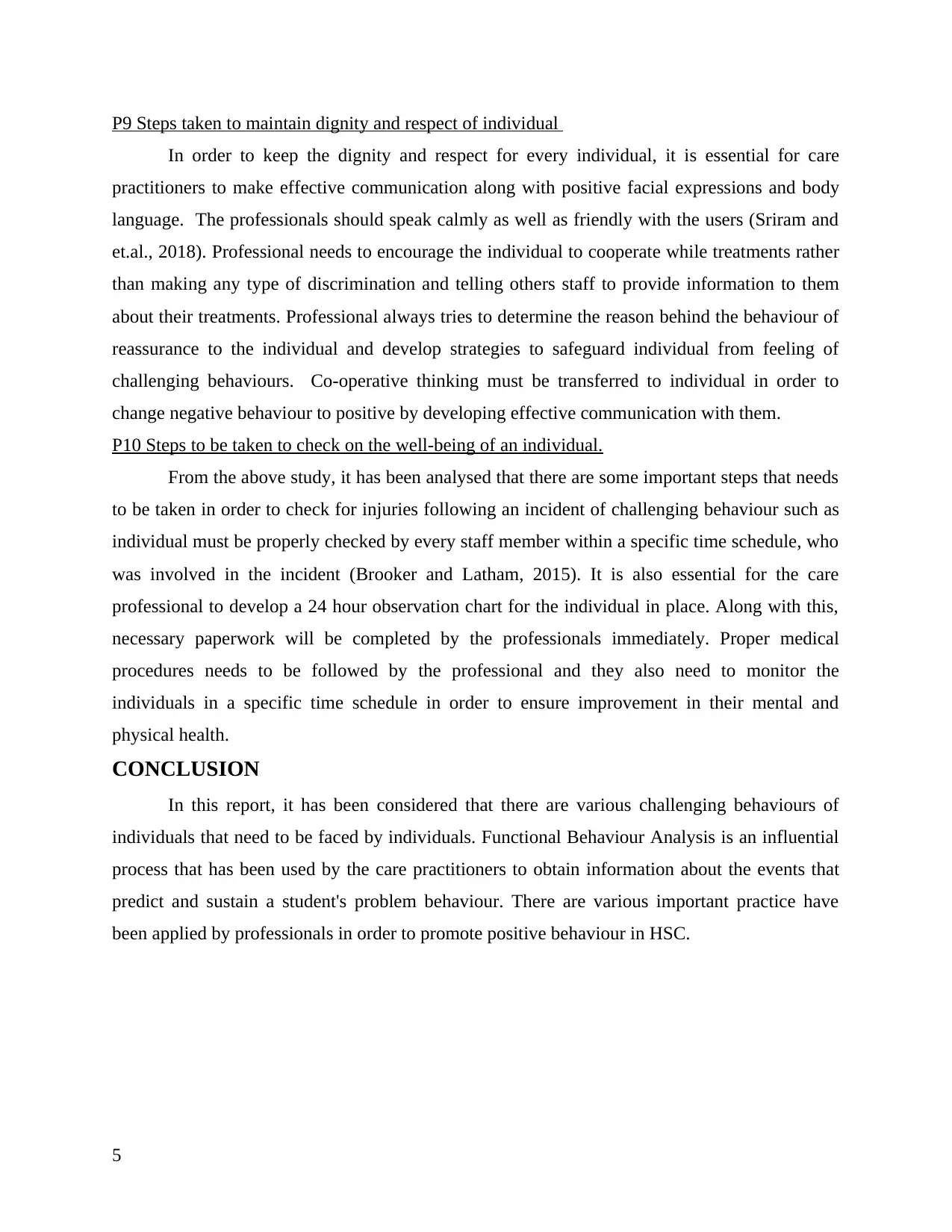
P9 Steps taken to maintain dignity and respect of individual
In order to keep the dignity and respect for every individual, it is essential for care
practitioners to make effective communication along with positive facial expressions and body
language. The professionals should speak calmly as well as friendly with the users (Sriram and
et.al., 2018). Professional needs to encourage the individual to cooperate while treatments rather
than making any type of discrimination and telling others staff to provide information to them
about their treatments. Professional always tries to determine the reason behind the behaviour of
reassurance to the individual and develop strategies to safeguard individual from feeling of
challenging behaviours. Co-operative thinking must be transferred to individual in order to
change negative behaviour to positive by developing effective communication with them.
P10 Steps to be taken to check on the well-being of an individual.
From the above study, it has been analysed that there are some important steps that needs
to be taken in order to check for injuries following an incident of challenging behaviour such as
individual must be properly checked by every staff member within a specific time schedule, who
was involved in the incident (Brooker and Latham, 2015). It is also essential for the care
professional to develop a 24 hour observation chart for the individual in place. Along with this,
necessary paperwork will be completed by the professionals immediately. Proper medical
procedures needs to be followed by the professional and they also need to monitor the
individuals in a specific time schedule in order to ensure improvement in their mental and
physical health.
CONCLUSION
In this report, it has been considered that there are various challenging behaviours of
individuals that need to be faced by individuals. Functional Behaviour Analysis is an influential
process that has been used by the care practitioners to obtain information about the events that
predict and sustain a student's problem behaviour. There are various important practice have
been applied by professionals in order to promote positive behaviour in HSC.
5
In order to keep the dignity and respect for every individual, it is essential for care
practitioners to make effective communication along with positive facial expressions and body
language. The professionals should speak calmly as well as friendly with the users (Sriram and
et.al., 2018). Professional needs to encourage the individual to cooperate while treatments rather
than making any type of discrimination and telling others staff to provide information to them
about their treatments. Professional always tries to determine the reason behind the behaviour of
reassurance to the individual and develop strategies to safeguard individual from feeling of
challenging behaviours. Co-operative thinking must be transferred to individual in order to
change negative behaviour to positive by developing effective communication with them.
P10 Steps to be taken to check on the well-being of an individual.
From the above study, it has been analysed that there are some important steps that needs
to be taken in order to check for injuries following an incident of challenging behaviour such as
individual must be properly checked by every staff member within a specific time schedule, who
was involved in the incident (Brooker and Latham, 2015). It is also essential for the care
professional to develop a 24 hour observation chart for the individual in place. Along with this,
necessary paperwork will be completed by the professionals immediately. Proper medical
procedures needs to be followed by the professional and they also need to monitor the
individuals in a specific time schedule in order to ensure improvement in their mental and
physical health.
CONCLUSION
In this report, it has been considered that there are various challenging behaviours of
individuals that need to be faced by individuals. Functional Behaviour Analysis is an influential
process that has been used by the care practitioners to obtain information about the events that
predict and sustain a student's problem behaviour. There are various important practice have
been applied by professionals in order to promote positive behaviour in HSC.
5
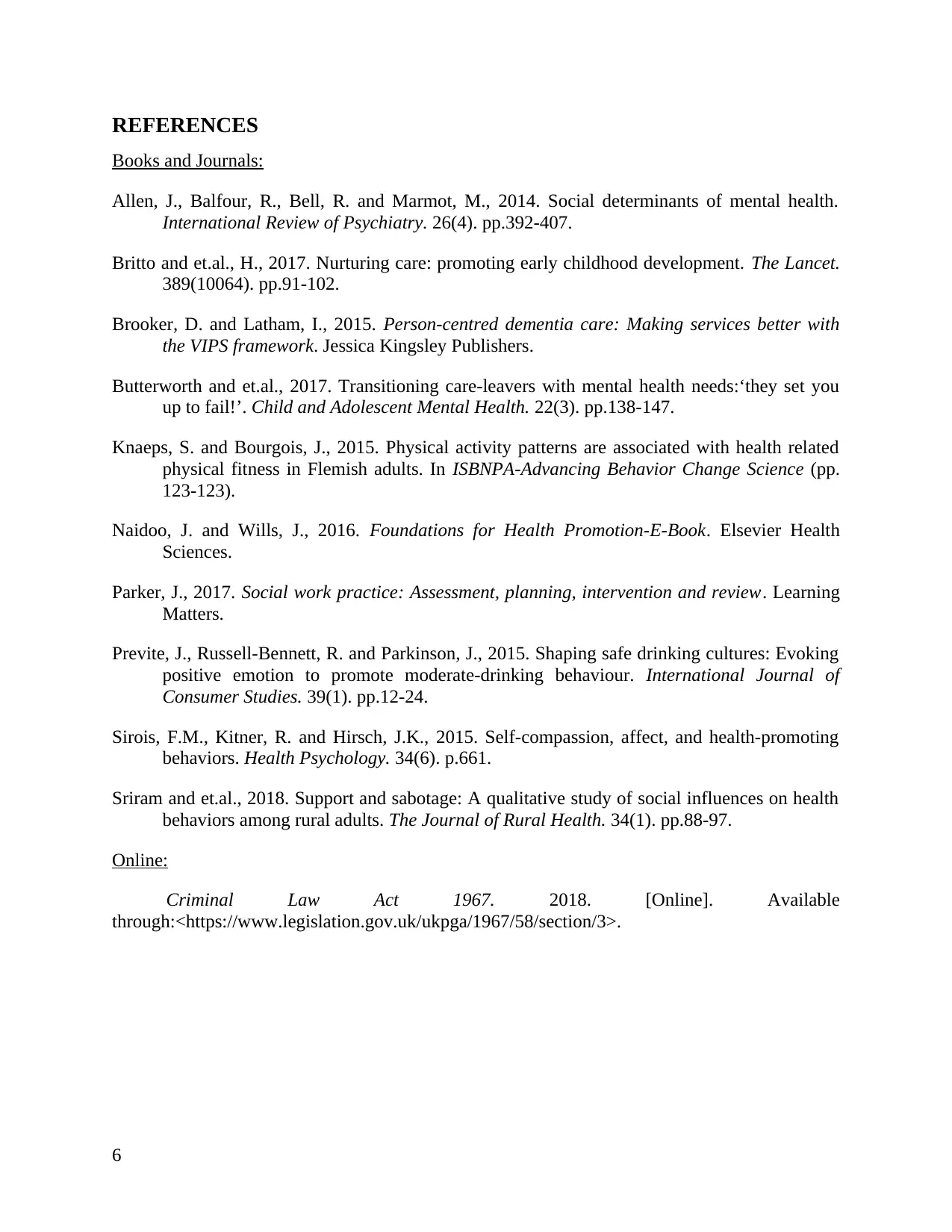
REFERENCES
Books and Journals:
Allen, J., Balfour, R., Bell, R. and Marmot, M., 2014. Social determinants of mental health.
International Review of Psychiatry. 26(4). pp.392-407.
Britto and et.al., H., 2017. Nurturing care: promoting early childhood development. The Lancet.
389(10064). pp.91-102.
Brooker, D. and Latham, I., 2015. Person-centred dementia care: Making services better with
the VIPS framework. Jessica Kingsley Publishers.
Butterworth and et.al., 2017. Transitioning care‐leavers with mental health needs:‘they set you
up to fail!’. Child and Adolescent Mental Health. 22(3). pp.138-147.
Knaeps, S. and Bourgois, J., 2015. Physical activity patterns are associated with health related
physical fitness in Flemish adults. In ISBNPA-Advancing Behavior Change Science (pp.
123-123).
Naidoo, J. and Wills, J., 2016. Foundations for Health Promotion-E-Book. Elsevier Health
Sciences.
Parker, J., 2017. Social work practice: Assessment, planning, intervention and review. Learning
Matters.
Previte, J., Russell‐Bennett, R. and Parkinson, J., 2015. Shaping safe drinking cultures: Evoking
positive emotion to promote moderate‐drinking behaviour. International Journal of
Consumer Studies. 39(1). pp.12-24.
Sirois, F.M., Kitner, R. and Hirsch, J.K., 2015. Self-compassion, affect, and health-promoting
behaviors. Health Psychology. 34(6). p.661.
Sriram and et.al., 2018. Support and sabotage: A qualitative study of social influences on health
behaviors among rural adults. The Journal of Rural Health. 34(1). pp.88-97.
Online:
Criminal Law Act 1967. 2018. [Online]. Available
through:<https://www.legislation.gov.uk/ukpga/1967/58/section/3>.
6
Books and Journals:
Allen, J., Balfour, R., Bell, R. and Marmot, M., 2014. Social determinants of mental health.
International Review of Psychiatry. 26(4). pp.392-407.
Britto and et.al., H., 2017. Nurturing care: promoting early childhood development. The Lancet.
389(10064). pp.91-102.
Brooker, D. and Latham, I., 2015. Person-centred dementia care: Making services better with
the VIPS framework. Jessica Kingsley Publishers.
Butterworth and et.al., 2017. Transitioning care‐leavers with mental health needs:‘they set you
up to fail!’. Child and Adolescent Mental Health. 22(3). pp.138-147.
Knaeps, S. and Bourgois, J., 2015. Physical activity patterns are associated with health related
physical fitness in Flemish adults. In ISBNPA-Advancing Behavior Change Science (pp.
123-123).
Naidoo, J. and Wills, J., 2016. Foundations for Health Promotion-E-Book. Elsevier Health
Sciences.
Parker, J., 2017. Social work practice: Assessment, planning, intervention and review. Learning
Matters.
Previte, J., Russell‐Bennett, R. and Parkinson, J., 2015. Shaping safe drinking cultures: Evoking
positive emotion to promote moderate‐drinking behaviour. International Journal of
Consumer Studies. 39(1). pp.12-24.
Sirois, F.M., Kitner, R. and Hirsch, J.K., 2015. Self-compassion, affect, and health-promoting
behaviors. Health Psychology. 34(6). p.661.
Sriram and et.al., 2018. Support and sabotage: A qualitative study of social influences on health
behaviors among rural adults. The Journal of Rural Health. 34(1). pp.88-97.
Online:
Criminal Law Act 1967. 2018. [Online]. Available
through:<https://www.legislation.gov.uk/ukpga/1967/58/section/3>.
6
⊘ This is a preview!⊘
Do you want full access?
Subscribe today to unlock all pages.

Trusted by 1+ million students worldwide
1 out of 6
Related Documents
Your All-in-One AI-Powered Toolkit for Academic Success.
+13062052269
info@desklib.com
Available 24*7 on WhatsApp / Email
![[object Object]](/_next/static/media/star-bottom.7253800d.svg)
Unlock your academic potential
Copyright © 2020–2025 A2Z Services. All Rights Reserved. Developed and managed by ZUCOL.





